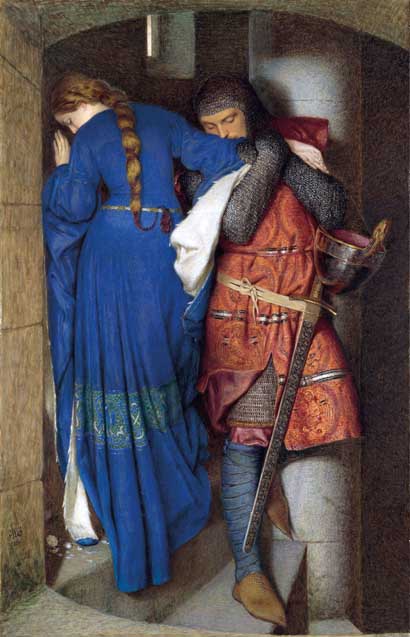200th anniversary of Frederic William Burton, 1816–1900
Published in Issue 1 (January/February 2016), News, Volume 24‘HE SERVED HIS COUNTRY, AND LOVED HIS KIND’—THOMAS DAVIES
By Marie Bourke

Frederic William Burton’s Hellelil and Hildebrand, the Meeting on the Turret Stairs (1864)—voted Ireland’s favourite painting in 2012. (National Gallery of Ireland)
Although 2016 marks an important year for significant Irish commemorative events, do not miss the anniversary in April of Frederic William Burton, the leading nineteenth-century artist, antiquarian and director (see HI 20.5, Sept./Oct. 2012, pp 34–7).
Born on 8 April 1816, Frederic Burton grew up in Corofin, Co. Clare, was educated at the Dublin Society Drawing Schools and was apprenticed to the artist Samuel Lover (1797–1868). Having started out as a painter of portraits and miniatures in watercolour, he also mixed in antiquarian circles that included George Petrie (1790–1866), who drew his attention to the west of Ireland. The Aran Fisherman’s Drowned Child (1841) is a genre painting and key work of Burton’s early career. It is a pre-Famine image, depicting the aftermath of the tragic drowning of a child, and also reflects the artist’s strong feelings about the people of the west, their customs and traditions. Burton executed over 50 studies for the work, which was completed in the studio, where he modelled the fisherman, his wife and drowned child on friends and relatives, while paying careful attention to the costumes and setting. The painting brought him public recognition and acclaim, and became the most popular print ever produced by the Royal Irish Art Union. Burton continued to exhibit at the Royal Hibernian Academy and the Royal Academy, London, before travelling overseas in the 1840s and 1850s to paint and study the collections in Germany. He also pursued his interest in Irish history and antiquities when he served on the council of the Royal Irish Academy (1846–52), at a time when the Academy was acquiring major Irish antiquities.
In 1858 Burton settled in London, establishing himself as a painter of portraits and subject pictures. Although he mixed in Pre-Raphaelite circles, he was never a member of the movement. Despite this, his masterpiece, Hellelil and Hildebrand, the Meeting on the Turret Stairs (1864), executed at the height of his career, reflects many Pre-Raphaelite influences and connections. Twenty-four studies for the work were included in the executor’s sale. The painting was inspired by a Danish ballad translated by Whitley Stokes and published in Fraser’s Magazine in 1855. It tells the tragic story of the knight Hildebrand, who fell for his charge, Hellelil, as a result of which he was killed. The picture shows a specific moment when the knight embraces his lover’s arm as she scatters flowers on the stair, symbolising the brevity of the affair and its destructive nature. In the words of the writer and poet George Eliot: ‘The subject might have been made the most vulgar thing in the world—the artist has raised it to the highest pitch of refined emotion’. Popular since it was first exhibited in 1864 at the Old Watercolour Society Annual Exhibition in London, the image, which continues to cause a stir, was voted Ireland’s favourite painting in 2012. The picture was held in private collections before being purchased in 1898 by Margaret Stokes, who left it as part of a bequest to the National Gallery of Ireland (1900).
Although he was a cultured and well-travelled figure, familiar with all the main European museums, and a fellow of the Society of Antiquaries (1863), it still came as a surprise when Burton was appointed director of the National Gallery, London (1874–94). The artist ceased painting and threw his energies into the growing gallery, working on a catalogue of the collection and overseeing important building extensions. His most important contribution to that institution was the acquisition of over 500 works, including Leonardo’s Virgin of the Rocks. Burton was knighted in 1884 and received an honorary LL.D from Trinity College, Dublin, in 1889. He is buried in Mount Jerome cemetery.
The artist retained a very strong interest in his native country throughout his life, particularly during the Irish literary revival, when Lady Gregory kept him updated. He never married and kept in close contact with family and friends. Having donated works to the National Gallery of Ireland in the course of his life, he kept in regular contact with its directors on their visits to London. In 1900 the National Gallery of Ireland held a popular and well-attended loan exhibition of 104 drawings and watercolours by Burton. Two hundred years after his birth, Frederic William Burton is firmly established as one of Ireland’s favourite painters. Look out for events marking Burton’s Anniversary at www.nationalgallery.ie.
Marie Bourke is former Keeper and Head of Education at the National Gallery of Ireland.
















